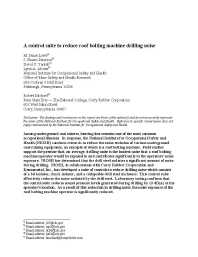Mining Publication: A Control Suite to Reduce Roof Bolting Machine Drilling Noise
Original creation date: April 2010
Among underground coal miners, hearing loss remains one of the most common occupational illnesses. In response, the National Institute for Occupational Safety and Health (NIOSH) conducts research to reduce the noise emission of various underground coal-mining equipment, an example of which is a roof bolting machine. Field studies support the premise that, on average, drilling noise is the loudest noise that a roof bolting machine operator would be exposed to and contributes significantly to the operators’ noise exposure. NIOSH has determined that the drill steel radiates a significant amount of noise during drilling. NIOSH, in collaboration with Corry Rubber Corporation and Kennametal, Inc., has developed a suite of controls to reduce drilling noise which consists of a bit isolator, chuck isolator, and a collapsible drill steel enclosure. This control suite effectively reduces the noise radiated by the drill steel. Laboratory testing confirms that the control suite reduces sound pressure levels generated during drilling by 13 dB(A) at the operator's location. As a result of this reduction in drilling noise, the noise exposure of the roof bolting machine operator is significantly reduced.
Authors: MJ Lowe, JS Peterson, LA Alcorn, DS Yantek, RJ Michael
Conference Paper - April 2010
NIOSHTIC2 Number: 20036773
NOISE-CON 2010: Proceedings of the 2010 National Conference on Noise Control Engineering and 159th Meeting of the Acoustical Society of America, Baltimore, Maryland, April 19-21, 2010. Burroughs CB; Maling G; eds., Indianapolis, IN: Institute of Noise Control Engineering of the USA, Paper No. NC 10-172, 2010; :1-12
See Also
- The Development of a Damped Drill Steel to Reduce Roof Bolting Machine Drilling Noise
- The Evolution of Drill Bit and Chuck Isolators to Reduce Roof Bolting Machine Drilling Noise
- Hearing Loss Prevention in Mining - 2005
- Hearing Loss Prevention in Mining - 2006
- Less Sound Underground: Reducing Roof Bolting Machine Drilling Noise
- A Noise Control for A Roof Bolting Machine: Collapsible Drill Steel Enclosure
- Noise Controls For Roof Bolting Machines
- Results of Noise Measurements from Underground Testing of a Roof Bolting Machine Duty Cycle
- Sound Power Level Study of a Roof Bolter
- Technology News 539 - Identifying The Benefits Of Engineering Noise Controls Through A Business Case
- Page last reviewed: 9/21/2012
- Page last updated: 9/21/2012
- Content source: National Institute for Occupational Safety and Health, Mining Program


 ShareCompartir
ShareCompartir
